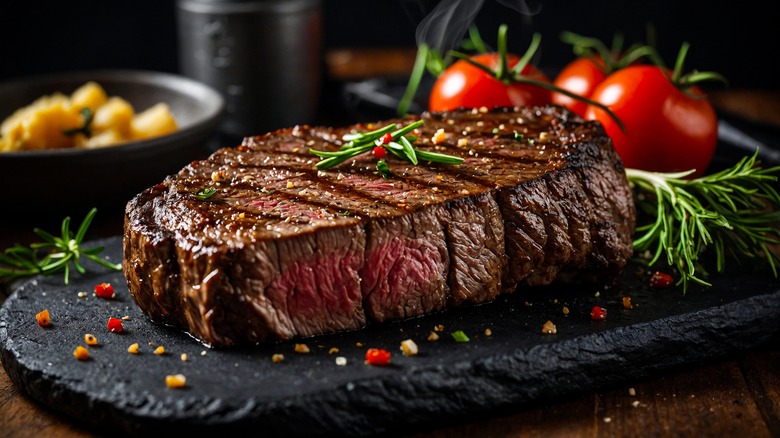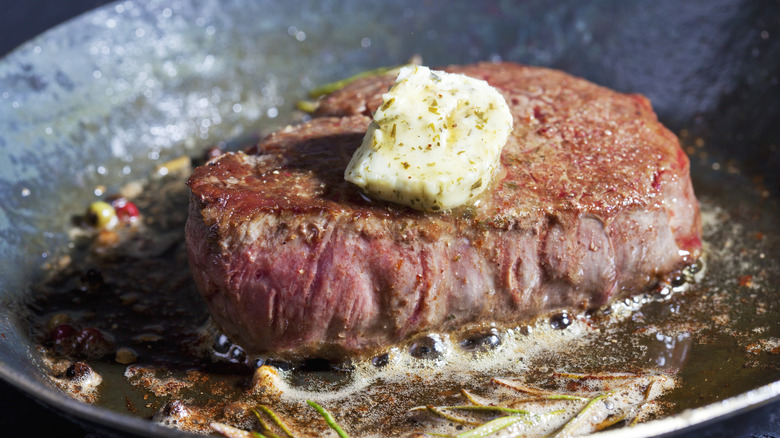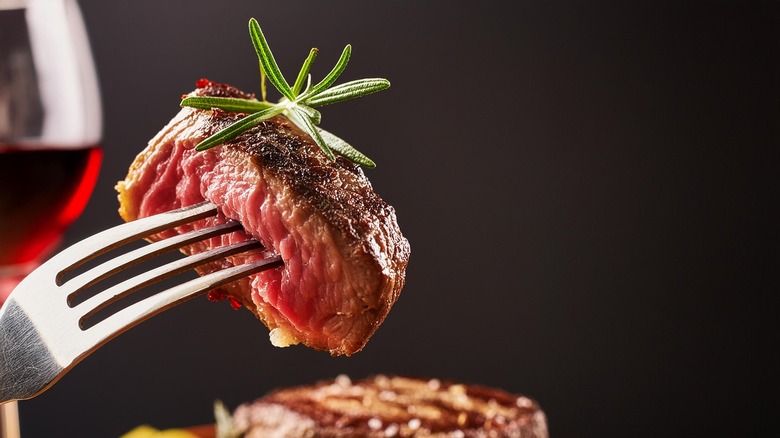How To Tell If A Steak Is Done With Just A Touch
Making that perfect steak isn't easy. Sometimes, you have to learn from trial and error — but fortunately, there are a few tricks you can pick up along the way. Some people swear by the 3-3-2-2 method for that perfectly seared steak. Some (dubiously) swear that you can make a solid steak in an air fryer. But if you missed out on that trend (or just shudder at the thought of abusing a good steak), chef K.C. Gulbro has some solid advice.
Gulbro is Chef Ambassador for Certified Angus Beef and owner of both FoxFire restaurant and the Copper Fox event venue in Geneva, Illinois. He's been running Foxfire for over 20 years, but his experience in the food industry goes back even further: he got his first restaurant job at age 16. Gulbro spoke with The Takeout about his favorite methods for figuring out whether a steak is done. While he prefers to use a thermometer, he has a backup method that comes in (ahem) handy if there's no thermometer to be found.
"Using a probe thermometer is the most accurate way to determine if the steak is done, but the touch method can also be a great indicator," said Gulbro. "You poke the palm of your opposite hand with your pointer finger. By touching different fingers with your thumb on the palm hand, you can feel different levels of firmness in the palm below your thumb."
How to use the finger and palm method
By comparing the firmness of your hand to the firmness of the meat, you can gauge if the meat is cooked to your liking. "Touching the palm without touching fingers is rare," Gulbro explained. "Index finger to thumb indicates medium rare, middle finger to thumb is medium, ring finger to thumb is medium well, and pinky finger to thumb signals well done." Having trouble visualizing it? Make an "okay" sign with your thumb and pointer finger, then prod the fleshy base of your thumb with your opposite hand. According to Gulbro's guidelines, that's what a medium-rare steak should feel like. As you move your thumb to touch each finger, the muscle tightens and the flesh gets increasingly firm.
Even if you know what a medium-rare steak should feel like, the touch method is a helpful reference. "I will temp or touch my steaks a few times while cooking," Gulbro said. "By touching it, I can determine how fast it is cooking and estimate the length of cooking left."
Remember: Steaks can keep cooking after they're removed from the pan, so you might want to take the meat out before you think it's done. "The thinner the cut, the faster they will keep cooking. This means that a medium-rare flat iron or skirt steak might become medium well if it rests for too long," said Gulbro.
Does the finger and palm method always work?
The palm method isn't foolproof: there are a lot of variables at play. For one, some people's hands are squishier than others. A construction worker will have a lot more calluses than the pampered palm of a professional hand model. Still, it's a solid guideline to keep in mind: You'll figure out how your hand correlates with practice.
But hands aren't the only problem: the type of meat matters, too. "Not all steaks will feel the same ... How they are aged can affect the touch method. Wet-aged steaks are easier to cook with this method than dry-aged," Gulbro said. If you're willing to drop a few bucks on a thermometer, you'll get more consistent results. "For dry-aged steaks, I will usually always use a thermometer as they are firmer," he added. "Checking with a probe will give you the perfect finish."


